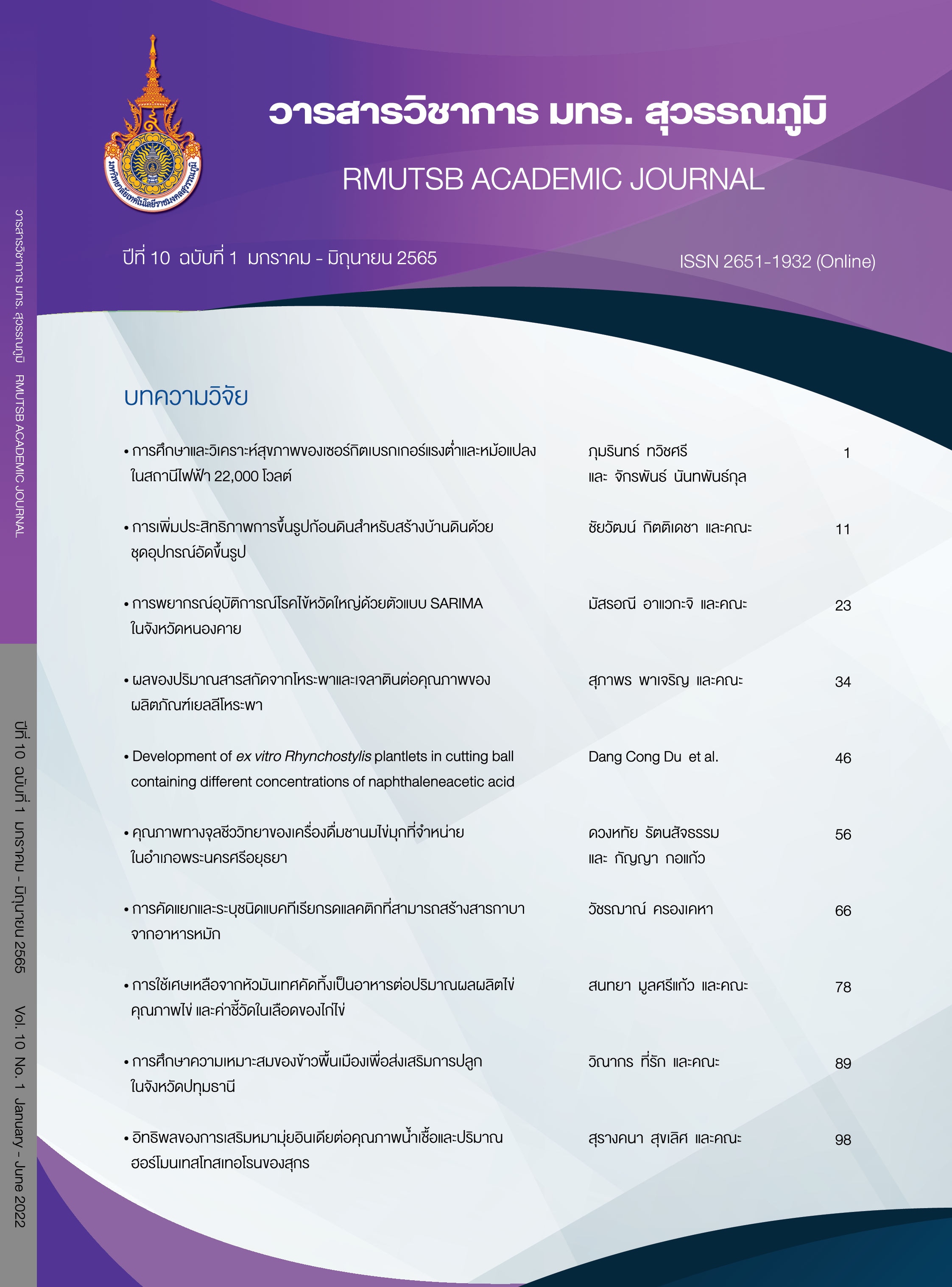การใช้เศษเหลือจากหัวมันเทศคัดทิ้งเป็นอาหารต่อปริมาณผลผลิตไข่ คุณภาพไข่ และค่าชี้วัดในเลือดของไก่ไข่
Main Article Content
บทคัดย่อ
หัวมันเทศคัดทิ้งเป็นเศษเหลือที่มีมากและราคาถูก การวิจัยครั้งนี้มีวัตถุประสงค์เพื่อศึกษาผลของการใช้เศษเหลือจากหัวมันเทศคัดทิ้งเป็นอาหารไก่ไข่ต่อผลผลิตไข่ คุณภาพไข่ และค่าชี้วัดในเลือด วางแผนการทดลองแบบสุ่มสมบูรณ์ (completely randomized design, CRD) โดยใช้ไก่พันธุ์โรมันบราวน์ อายุ 41 สัปดาห์ จำนวน 150 ตัว แบ่งเป็น 5 กลุ่มทดลอง กลุ่มที่ 1 กลุ่มควบคุมสารสีเชิงลบให้อาหารสูตรมันเส้นเป็นหลัก (CM) กลุ่มที่ 2 กลุ่มควบคุมเชิงบวกให้อาหารสูตรข้าวโพดเป็นหลัก (C) กลุ่มที่ 3 (SPT50) กลุ่มที่ 4 (SPT75) และกลุ่มที่ 5 (SPT100) ให้อาหารสูตรเศษเหลือจากหัวมันเทศทดแทนข้าวโพดที่ระดับ 50, 75 และ 100 เปอร์เซ็นต์ ตามลำดับ ผลการทดลองพบว่ากลุ่ม SPT50 และกลุ่ม SPT75 มีเปอร์เซ็นต์ผลผลิตไข่และมวลไข่สูงกว่ากลุ่ม SPT100 และค่าอัตราการเปลี่ยนอาหารเป็นไข่ดีกว่ากลุ่ม C (P<0.05) ส่วนความสูงไข่ขาว ค่าฮอร์กยูนิต ดัชนีไข่แดง และความหนาเปลือกไข่ในทุกกลุ่มทดลองไม่แตกต่างกันทางสถิติ (P>0.05) แต่ผลผลิตไข่ มวลไข่และสีไข่แดงของกลุ่ม CM มีค่าต่ำกว่ากลุ่มอื่น (P<0.05) ส่วนค่าชี้วัดในเลือดของทุกกลุ่มทดลองไม่แตกต่างกันทางสถิติ (P>0.05) ผลการวิจัยบ่งชี้ว่าเศษเหลือจากหัวมันเทศคัดทิ้งสามารถใช้ทดแทนมันเส้นได้ทั้งหมดและทดแทนข้าวโพดบดได้ที่ระดับ 50 และ 75 เปอร์เซ็นต์ในสูตรอาหาร โดยไม่กระทบกับผลผลิตไข่ คุณภาพไข่ และค่าชี้วัดในเลือด อีกทั้งใช้เป็นแหล่งของสารสีให้ไข่แดงเช่นเดียวกับข้าวโพดและลดต้นทุนค่าอาหารต่อการผลิตไข่ได้เฉลี่ยกิโลกรัมละ 4.71 บาท
Article Details

อนุญาตภายใต้เงื่อนไข Creative Commons Attribution-NonCommercial-NoDerivatives 4.0 International License.
ต้นฉบับที่ได้รับการตีพิมพ์ถือเป็นสิทธิของเจ้าของต้นฉบับและของวารสารวิชาการ มทร.สุวรรณภูมิ เนื้อหาบทความในวารสารเป็นแนวคิดของผู้แต่ง มิใช่เป็นความคิดเห็นของคณะกรรมการการจัดทำวารสาร และมิใช่ความรับผิดชอบของมหาวิทยาลัยเทคโนโลยีราชมงคลสุวรรณภูมิ
เอกสารอ้างอิง
Afolayan, S. B., Dafwang, I. I., Sekoni, A., & Jegede, J. O. (2013). Effect of dietary maize substitution with sweet potato meal on performance of grower (10-22 weeks) and subsequent egg production (23-35 weeks). Asian Journal of Poultry Science, 7(2), 55-64.
Ahn, Y. O., Kim, S., Kim, C., Lee, J., Sang-Soo, K., & Haeng-Soon, L. (2010). Exogeneous sucrose utilization and starch biosynthesis among sweet potato cultivars. Carbohydrate Research, 345, 55-60.
AOAC. (2000). Association official method of analysis. Maryland: AOAC International.
Ayuk, E. A. (2004). Effect of sweet potato meal on the growth rate of broilers. Livestock Research for Rural Development, 16(2004), Retrieved 20 March, 2020, from http://www.lrrd.org/lrrd16/9/ayuk16073.html
Beckford, R. C., & Bartlett, J. R. (2015). Inclusion levels of sweet potato root meal in the diet of broilers I. Effect on performance, organ weights, and carcass quality. Poultry Science, 94(6), 1316-1322.
Biswas, A. K., Sahoo, J., & Chatli, M. K. (2011). A simple UV-Vis spectrophotometric method for determination of Beta-carotene content in raw carrot, sweet potato and supplemented chicken meat nuggets. Food Science and Technology, 44, 1809-1813.
Byamukama, E. R., Gibson, W., Aritua, V., & Adipala, E. (2003). Within-crop spread of sweet potato virus disease and the population dynamics of its whitefly and aphid vectors. Journal of Crop Protection, 23, 109-116.
Çaliskan, M. E., Sogut, T., Boydak, E., Erturk, E., & Arioglu, H. (2007). Growth, yield and quality of sweet potato [Ipomoea batatas (L.) Lam.] cultivars in the Southeastern Anatolian and East Mediterranean regions of Turkey. Turkish Journal of Agriculture and Forestry, 31, 213-227.
Dangpium, N. (2015). Research and development project for sweet potato production (research report). Bangkok: Department of Agriculture.
Gross, W. B., & Siegel, P. B. (1986). Effect of initial and second periods of fasting on heterophil/lymphocyte ratios and BW. Avian Diseases, 30, 345-346.
Kassa, M., Negesse, T., & Nurfeta, A. (2017). Effect of replacing maize (Zea mays L.) with orange fleshed sweet potato tuber (Ipomoea batatas) on performance of Cobb500 broiler chickens. Agricultural Research & Technology: Open Access Journal, 5, 1-9.
Kaya, S., & Yildirim, H. (2011). The effect of dried sweet potato (Ipomoea batatas) vines on egg yolk color and some egg yield parameters. International Journal of Agriculture & Biology, 13(5), 766-770.
Ladokun, O. A., Aderemi, F. A., & Tewe, O. O. (2007). Sweet potato as a feed resource for layer production in Nigeria. 8th African Crop Science Society Conference (pp. 585-588). El-Minia Egypt: African Crop Science Society.
Moonsrikeaw, S. (2018). The study of nutritive values and utilization of by – product from sweet potato for feedstuff (research report). Phra Nakhon Si Ayutthaya: Rajamangala University of Technology Suvarnabhumi.
National Research Council (NRC). (1994). Nutrient requirements for poultry. Washington DC: Natl Acad.
Nuhu, B., Abba, A., & Aminu, L. (2008). Profitability of broiler chickens raised on graded levels of maize offal and wheat offal based diets. Proceedings of Annual ASAN Conference (pp. 298-299). Abu Zaria: Nigeria.
Ravindran, V. (1995). Use of cassava and sweet potatoes in animal feeding. Rome: FAO.
Reece, O. W. (2006). Functional anatomy and physiology of domestic animals. Iowa: Blackwell Publishing.
Teow, C. C., Truong, V. D., McFeeters, R. F., Thompson, R. L., Pecota, K. V., & Yencho, G. C. (2007). Antioxidant activities, phenolic and β-carotene contents of sweet potatoes genotypes with varying flesh colours. Food Chemistry, 103, 829-838.
Tonglak, P. (2016). Food product development from sweet potato in Tub-Nam, Bang Pahan, Phra Nakhon Si Ayutthaya (research report). Phra Nakhon Si Ayutthaya: Rajamangala University of Technology Suvarnabhumi.


